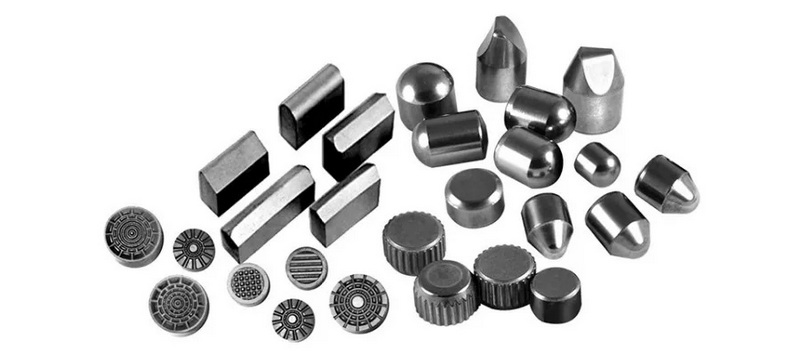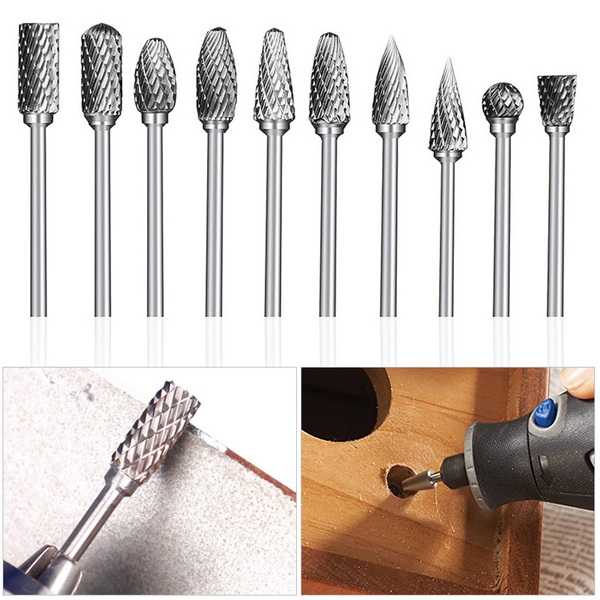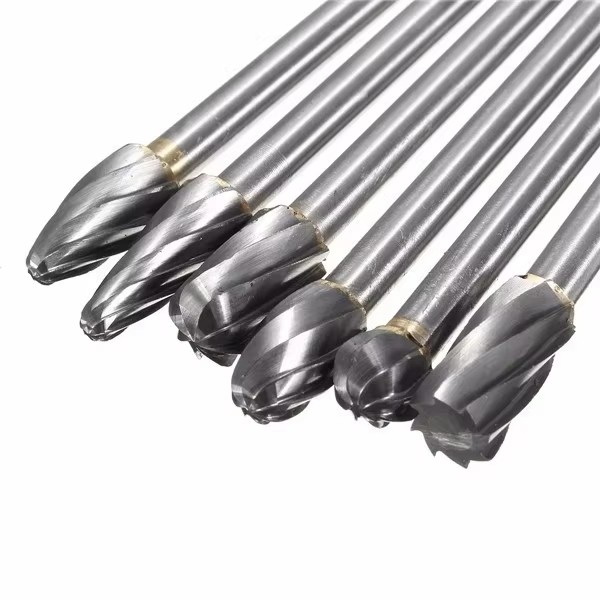Content Menu
● Introduction to Tungsten Carbide
>> Properties of Tungsten Carbide
● Assessing the Need for Sharpening
● Sharpening Techniques for Tungsten Carbide
>> 1. Diamond Wheels
>> 2. Diamond Laps
>> 3. Ultrasonic Sharpening
>> 4. Electrochemical Grinding
>> 5. Professional Sharpening Services
● Using a Dremel for Sharpening
>> Steps to Sharpen with a Dremel:
● Advanced Sharpening Techniques
● Safety Precautions
● Storage and Maintenance
● Conclusion
● FAQ
>> 1. What is the best method for sharpening tungsten carbide tools?
>> 2. Can I use a Dremel to sharpen tungsten carbide tools?
>> 3. Why is tungsten carbide so hard to sharpen?
>> 4. What safety precautions should I take when sharpening with power tools?
>> 5. How often should I sharpen my tungsten carbide tools?
● Citations:
Sharpening tungsten carbide tools, including those used with a Dremel, requires specialized techniques and equipment due to their exceptional hardness. Tungsten carbide is renowned for its high wear resistance and strength, making it ideal for cutting and shaping hard materials. However, even these durable tools eventually need sharpening to maintain their effectiveness. In this article, we will explore the methods and tools necessary for sharpening tungsten carbide Dremel bits, providing detailed instructions, safety guidelines, and maintenance tips to ensure you can keep your tools in optimal condition.

Introduction to Tungsten Carbide
Tungsten carbide is a composite material consisting of tungsten carbide particles bonded together by a metallic matrix, typically cobalt. This composition gives it a unique combination of hardness and toughness. Its hardness is comparable to diamond, which makes it suitable for applications requiring high wear resistance, such as cutting tools, drill bits, and various industrial components. However, this hardness also poses a challenge when it comes to sharpening.
Properties of Tungsten Carbide
- High Hardness: Tungsten carbide has a Mohs hardness of about 8-9, which is significantly harder than most metals. This allows it to cut through hard materials without rapidly wearing down.
- High Wear Resistance: It resists abrasion and wear exceptionally well, making it ideal for cutting tools that are subjected to constant friction and pressure.
- High Corrosion Resistance: It is resistant to corrosion from many chemicals and environmental factors, which extends its lifespan in harsh conditions.
- High Temperature Resistance: Tungsten carbide maintains its hardness and strength at high temperatures, making it suitable for high-speed cutting operations.
- High Compressive Strength: It can withstand high compressive forces without deforming or breaking, which is essential for tools that experience significant pressure during use.
Assessing the Need for Sharpening
Before sharpening, it's crucial to determine if your tungsten carbide tool needs sharpening. Sharpening prematurely can wear down the tool unnecessarily, while neglecting to sharpen can lead to inefficient cutting and increased risk of tool damage. Here are some methods to assess its condition:
1. Visual Inspection: Examine the cutting edge of the tool under good lighting. A sharp tool will have a clean, defined edge that reflects light evenly. A dull tool will have a rounded or chipped edge and will not reflect light as sharply.
2. Fingernail Test: Gently scrape the cutting edge of the tool with your fingernail at a shallow angle. If the tool catches and leaves a mark on your nail, it is likely sharp enough to use. If it slides smoothly without catching, it may need sharpening.
3. Performance Test: Try using the tool on a scrap piece of material. If the tool requires more force than usual, produces rough cuts, or creates excessive dust, it is likely dull and needs sharpening.
4. Magnification: Use a magnifying glass or microscope to examine the cutting edge more closely. This will help you identify small chips, cracks, or rounding that may not be visible to the naked eye.
Sharpening Techniques for Tungsten Carbide
Sharpening tungsten carbide requires specialized equipment due to its hardness. Attempting to sharpen it with conventional abrasives will be ineffective and can damage both the tool and the sharpening equipment. Here are some common methods:
1. Diamond Wheels
Diamond wheels are the most effective tool for sharpening tungsten carbide. They consist of diamond particles bonded to a metal or resin matrix and are designed to grind away the carbide without excessive heat buildup.
- Wet Grinding: This method involves using a diamond wheel with a coolant, such as water or oil, to dissipate heat and prevent thermal damage to the tool. Wet grinding is generally preferred for tungsten carbide because it minimizes the risk of cracking and prolongs the life of the diamond wheel. Ensure the coolant is directed at the point of contact between the tool and the wheel.
- Dry Grinding: While possible, dry grinding can lead to overheating and damage the tool. If dry grinding is necessary, use a low speed and apply light pressure to minimize heat buildup. Regularly inspect the tool for signs of overheating, such as discoloration or cracking.
2. Diamond Laps
Diamond laps are flat surfaces coated with diamond particles. They are used for honing and fine-tuning the edge of a tungsten carbide tool after it has been sharpened with a diamond wheel. Diamond laps are less aggressive than diamond wheels and are ideal for removing small imperfections and achieving a razor-sharp edge.
3. Ultrasonic Sharpening
Ultrasonic sharpening is a specialized technique that uses high-frequency vibrations to remove material from the tungsten carbide tool. This method is particularly effective for sharpening complex geometries and delicate tools. Ultrasonic sharpening machines are expensive and require specialized training to operate, so they are typically used in industrial settings.
4. Electrochemical Grinding
Electrochemical grinding (ECG) combines electrical and mechanical processes to remove material from the tool. In ECG, the tool is used as the anode in an electrolytic cell, and a conductive grinding wheel acts as the cathode. As the wheel rotates, an electrolyte solution is pumped between the tool and the wheel, causing the material to dissolve through electrochemical action. ECG is a precise and efficient method for sharpening tungsten carbide, but it requires specialized equipment and expertise.
5. Professional Sharpening Services
Given the complexity and potential for damage, it's often recommended to use professional sharpening services for tungsten carbide tools. Professional sharpeners have the necessary equipment, skills, and experience to sharpen tungsten carbide tools to their original specifications. They can also provide advice on tool maintenance and usage.

Using a Dremel for Sharpening
While not ideal for sharpening tungsten carbide due to its hardness, a Dremel can be used with a diamond wheel for small-scale sharpening tasks. This method is suitable for touching up the edges of small Dremel bits or performing minor repairs.
Steps to Sharpen with a Dremel:
1. Attach the Diamond Wheel: Select a Dremel diamond wheel attachment that is appropriate for the size and shape of the tool you are sharpening. Ensure the wheel is securely attached to the Dremel.
2. Set the Speed: Operate the Dremel at a moderate speed to avoid overheating. High speeds can generate excessive heat, which can damage the tool and the diamond wheel. A speed setting between 10,000 and 15,000 RPM is generally recommended.
3. Secure the Workpiece: Hold the tool in a vise or clamp to keep it steady during sharpening. This will help you maintain consistent angles and prevent accidents.
4. Sharpen the Tool: Hold the tool against the spinning diamond wheel at the correct angle. Use light pressure and move the tool slowly and steadily to maintain even sharpening. Avoid applying too much pressure, as this can damage the wheel and the tool.
5. Cooling: If possible, use a small amount of coolant, such as water, to keep the tool and the diamond wheel cool. This will help prevent overheating and prolong the life of both.
6. Inspect the Edge: After sharpening, inspect the cutting edge with a magnifying glass to ensure it is sharp and free of imperfections. If necessary, repeat the sharpening process until the desired sharpness is achieved.
Advanced Sharpening Techniques
For more advanced sharpening tasks, consider the following techniques:
1. Back Relief: Ensure the back of the cutting edge is properly relieved to prevent rubbing and reduce friction. This is especially important for tools used on soft materials.
2. Gullet Grinding: For tools with multiple cutting edges, such as rotary burrs, maintain the proper gullet depth and shape to ensure efficient chip removal.
3. Surface Finish: Use a fine-grit diamond wheel or lap to achieve a smooth surface finish on the cutting edge. This will improve the tool's cutting performance and extend its life.
Safety Precautions
When sharpening with power tools, safety is paramount:
- Wear Protective Gear: Always wear safety glasses to protect your eyes from flying debris. Use gloves to protect your hands from sharp edges and abrasive materials. Wear a dust mask or respirator to avoid inhaling dust particles, especially when dry grinding.
- Ensure Proper Ventilation: Work in a well-ventilated area to prevent the buildup of dust and fumes. If necessary, use a local exhaust ventilation system to remove airborne particles.
- Maintain Tool Condition: Regularly inspect tools for damage, such as cracks, chips, or loose parts. Replace or repair damaged tools immediately. Keep sharpening equipment clean and properly maintained.
- Handle Coolants Safely: If using coolants, follow the manufacturer's instructions for safe handling and disposal. Avoid contact with skin and eyes, and do not ingest.
- Emergency Procedures: Know the location of first aid supplies and emergency contact information. Be prepared to respond to accidents and injuries.
Storage and Maintenance
Proper storage and maintenance are essential for prolonging the life of your tungsten carbide tools. Here are some tips:
1. Clean Tools After Use: Remove any debris or residue from the tool after each use. Use a brush, cloth, or compressed air to clean the cutting edges and surfaces.
2. Store Tools Properly: Store tools in a dry, secure location where they will not be damaged or exposed to moisture. Use tool holders, cases, or drawers to keep tools organized and protected.
3. Regular Inspection: Inspect tools regularly for signs of wear, damage, or corrosion. Address any issues promptly to prevent further deterioration.
4. Lubrication: Apply a light coat of oil or rust inhibitor to the tool to protect it from corrosion, especially if it will be stored for an extended period.
5. Sharpen Regularly: Sharpen tools regularly to maintain their cutting performance and extend their lifespan. Follow the recommended sharpening intervals for each type of tool.
Conclusion
Sharpening tungsten carbide tools requires careful consideration of the tool's hardness and the appropriate sharpening method. Diamond wheels are the most effective tool for sharpening tungsten carbide, and using a Dremel with a diamond wheel can be a viable option for small tasks. Understanding the properties of tungsten carbide, assessing the need for sharpening, and employing the right techniques and safety measures are crucial for maintaining your tools. However, for precise and professional results, it's often best to seek out specialized sharpening services. By following the guidelines outlined in this article, you can ensure your tungsten carbide Dremel bits remain in optimal condition, providing efficient and accurate performance for years to come.

FAQ
1. What is the best method for sharpening tungsten carbide tools?
The best method for sharpening tungsten carbide tools is using a diamond wheel on an automatic grinder. This provides precision and maintains the tool's integrity. The diamond wheel should be of appropriate grit for the level of sharpening required, and wet grinding is generally preferred to minimize heat.
2. Can I use a Dremel to sharpen tungsten carbide tools?
Yes, you can use a Dremel with a diamond wheel for sharpening tungsten carbide tools, but it is best suited for small-scale tasks and may not provide the precision of professional equipment. Ensure the Dremel is operated at a moderate speed and that light pressure is applied to avoid overheating.
3. Why is tungsten carbide so hard to sharpen?
Tungsten carbide is hard to sharpen because of its exceptional hardness, which is comparable to diamond. This requires specialized tools like diamond wheels to effectively sharpen it, as conventional abrasives are not hard enough to remove material from tungsten carbide.
4. What safety precautions should I take when sharpening with power tools?
Always wear protective gear such as safety glasses, gloves, and a dust mask. Ensure proper ventilation to avoid inhaling dust particles, and maintain your tools to prevent accidents. Also, be mindful of the potential for overheating and use coolants when appropriate.
5. How often should I sharpen my tungsten carbide tools?
Sharpen your tungsten carbide tools when they show signs of wear, such as reduced performance or visible dullness. Regular sharpening extends the tool's lifespan and maintains its effectiveness. The frequency of sharpening will depend on the tool's usage and the materials it is used on.
Citations:
[1] https://www.linkedin.com/pulse/how-sharpen-tungsten-carbide-shijin-lei
[2] https://www.youtube.com/watch?v=glEW8K9kn64
[3] https://huanatools.com/6-facts-about-tungsten-carbide-burrs-and-how-to-use-them/
[4] https://www.dremel.com/storage/en-us/100-n-7-35029-original$pdf-246670-en-us.pdf
[5] https://www.youtube.com/watch?v=HqS5KAaltCg
[6] https://www.farnell.com/datasheets/3098172.pdf
[7] https://www.youtube.com/watch?v=-Rl8U95sHxI
[8] https://www.dremel.com/binaries/content/assets/dremel/us/products/rotary-accessory-guide.pdf
[9] https://www.youtube.com/watch?v=Fp44eKFzDpE
[10] https://www.aawforum.org/community/threads/sharpening-carbide-cutters.8417/
[11] https://www.youtube.com/watch?v=0RnQr-7u084
















